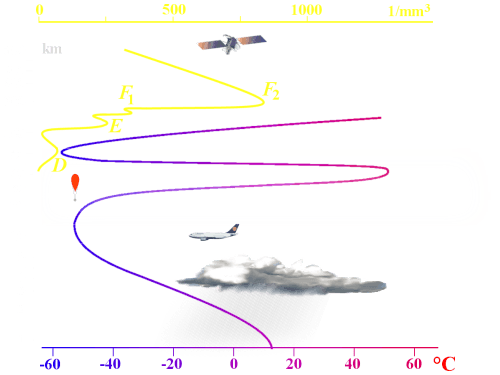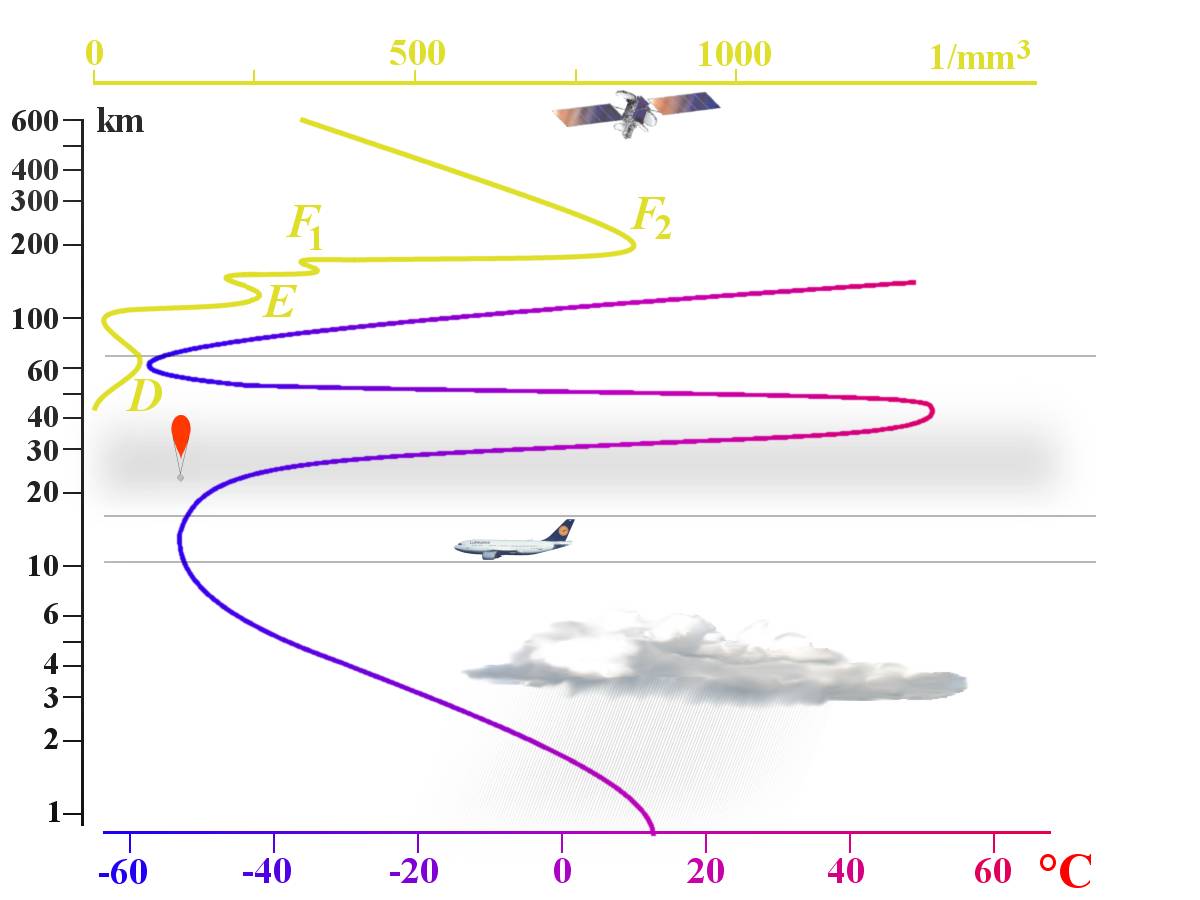The Earth's Atmosphere

Figure 1: The structure of the Earth's atmosphere

Figure 1: The structure of the Earth's atmosphere

Figure 1: The structure of the Earth's atmosphere
The Earth's Atmosphere
The influence exerted on radio waves by the Earth's atmosphere adds many factors to complicate what at first seems to be a relatively simple problem. These complications are because of a lack of uniformity within the Earth's atmosphere.
The Earth's atmosphere is divided into three separate regions, or layers. They are the:
- troposphere, the
- stratosphere, and the
- ionosphere.
The Troposphere
The troposphere is the part of the Earth's atmosphere that extends from the surface of the Earth to a height of about 3.7 miles (6 km) at the North Pole or the South Pole and 11.2 miles (18 km) at the equator. Virtually all weather phenomena take place in the troposphere. The temperature in this region decreases rapidly with altitude, clouds form, and there may be much turbulence because of variations in temperature, density, and pressure. These conditions have a great effect on the propagation of radio waves.
The Stratosphere
The stratosphere is located between the troposphere (11 km) and the ionosphere (80 km). The temperature throughout this region is considered to be almost constant and there is little water vapor present. The stratosphere has relatively little effect on radio waves because it is a relatively calm region with little or no temperature changes. An ozone layer develops in this area whose maximum ozone density is 25 km at ca.
This ozone layer is responsible for the absorption of a large part of the ultraviolet radiation of the sun. This radiation is health harmful.
The Ionosphere
The ionosphere extends upward from about 31.1 miles (50 km) to a height of about 250 miles (402 km). It contains four cloud-like layers of electrically charged ions, which enable radio waves to be propagated to great distances around the Earth.
Ionization occurs when high energy ultraviolet light waves from the sun enter the ionospheric region of the atmosphere, strike a gas atom, and literally knock an electron free from its parent atom. A normal atom is electrically neutral since it contains both a positive proton in its nucleus and a negative orbiting electron. When the negative electron is knocked free from the atom, the atom becomes positively charged (called a positive ion) and remains in space along with the free electron, which is negatively charged. This process of upsetting electrical neutrality is known as ionization.
The free negative electrons subsequently absorb part of the ultraviolet energy, which initially freed them from their atoms. As the ultraviolet light wave continues to produce positive ions and negative electrons, its intensity decreases because of the absorption of energy by the free electrons, and an ionized layer is formed. The rate at which ionization occurs depends on the density of atoms in the atmosphere and the intensity of the ultraviolet light wave, which varies with the activity of the sun.
Since the atmosphere is bombarded by ultraviolet light waves of different frequencies, several ionized layers are formed at different altitudes. Lower frequency ultraviolet waves penetrate the atmosphere the least; therefore, they produce ionized layers at the higher altitudes. Conversely, ultraviolet waves of higher frequencies penetrate deeper and produce layers at the lower altitudes.
The D layer ranges from about 30 to 55 miles. Ionization in the D layer is low because it is the lowest region of the ionosphere. This layer has the ability to refract signals of low frequencies. High frequencies pass right through it and are attenuated. After sunset, the D layer disappears because of the rapid recombination of ions.
The E layer limits are from about 55 to 90 miles. This layer is also known as the Kennelly-Heaviside layer, because these two men were the first to propose its existence. The rate of ionic recombination in this layer is rather rapid after sunset and the layer is almost gone by midnight. This layer has the ability to refract signals as high as 20 megahertz. For this reason, it is valuable for communications in ranges up to about 1500 miles.
The F layer exists from about 90 to 240 miles. During the daylight hours, the F layer separates into two layers, the F1 and F2 layers. The ionization level in these layers is quite high and varies widely during the day. At noon, this portion of the atmosphere is closest to the sun and the degree of ionization is maximum. Since the atmosphere is rarefied at these heights, recombination occurs slowly after sunset. Therefore, a fairly constant ionized layer is always present. The F layers are responsible for high-frequency, long distance transmission.
